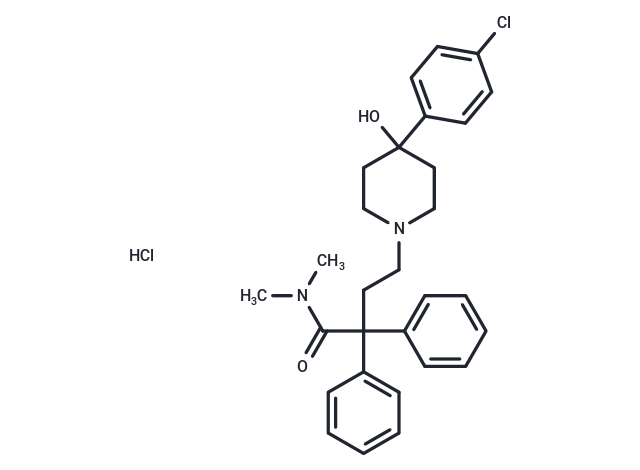Shopping Cart
Remove All Your shopping cart is currently empty
Your shopping cart is currently empty
Loperamide hydrochloride (ADL 2-1294) is a synthetic, piperidine derivative and opioid agonist with antidiarrheal activity.

| Pack Size | Price | USA Warehouse | Global Warehouse | Quantity |
|---|---|---|---|---|
| 50 mg | $37 | In Stock | In Stock | |
| 100 mg | $50 | In Stock | In Stock | |
| 500 mg | $77 | In Stock | In Stock | |
| 1 g | $109 | In Stock | In Stock | |
| 1 mL x 10 mM (in DMSO) | $50 | In Stock | In Stock |
| Description | Loperamide hydrochloride (ADL 2-1294) is a synthetic, piperidine derivative and opioid agonist with antidiarrheal activity. |
| Targets&IC50 | δ opioid receptor:48 nM(Ki), μ opioid receptor:3.3 nM(Ki) |
| In vitro | In mice, ropivacaine cannot cross the blood-brain barrier. Subcutaneous injection of ropivacaine at the neck region (4 mg/kg) or at the site of tibial tumor mass (7.5-75 mg) can inhibit thermal hyperalgesia and mechanical allodynia. |
| In vivo | In human Chinese hamster ovary cells transfected with opioid receptors, Loperamide potently stimulates the binding of [35S]guanosine 5'-O-(3-thio)triphosphate (EC50=56 nM) and inhibits the accumulation of cAMP induced by forskolin (IC50=25 nM). Loperamide reversibly blocks the increase in intracellular calcium ([Ca2+]i) triggered by extracellular potassium ([K+]o) in a concentration-dependent manner (IC50=0.9 mM). |
| Synonyms | R-18553 (hydrochloride), Loperamide HCl, ADL 2-1294 |
| Molecular Weight | 513.50 |
| Formula | C29H34Cl2N2O2 |
| Cas No. | 34552-83-5 |
| Smiles | Cl.CN(C)C(=O)C(CCN1CCC(O)(CC1)c1ccc(Cl)cc1)(c1ccccc1)c1ccccc1 |
| Relative Density. | 1.1905 g/cm3 (Estimated) |
| Color | White |
| Appearance | Solid |
| Storage | Powder: -20°C for 3 years | In solvent: -80°C for 1 year | Shipping with blue ice/Shipping at ambient temperature. | ||||||||||||||||||||||||||||||||||||||||
| Solubility Information | DMSO: 99 mg/mL (192.79 mM), Sonication is recommended. Ethanol: 10.3 mg/mL (20.06 mM), Sonication is recommended. | ||||||||||||||||||||||||||||||||||||||||
| In Vivo Formulation | 10% DMSO+40% PEG300+5% Tween 80+45% Saline: 3.3 mg/mL (6.43 mM), Sonication is recommended. Please add the solvents sequentially, clarifying the solution as much as possible before adding the next one. Dissolve by heating and/or sonication if necessary. Working solution is recommended to be prepared and used immediately. The formulation provided above is for reference purposes only. In vivo formulations may vary and should be modified based on specific experimental conditions. | ||||||||||||||||||||||||||||||||||||||||
Solution Preparation Table | |||||||||||||||||||||||||||||||||||||||||
Ethanol/DMSO
DMSO
| |||||||||||||||||||||||||||||||||||||||||
| Size | Quantity | Unit Price | Amount | Operation |
|---|

Copyright © 2015-2025 TargetMol Chemicals Inc. All Rights Reserved.